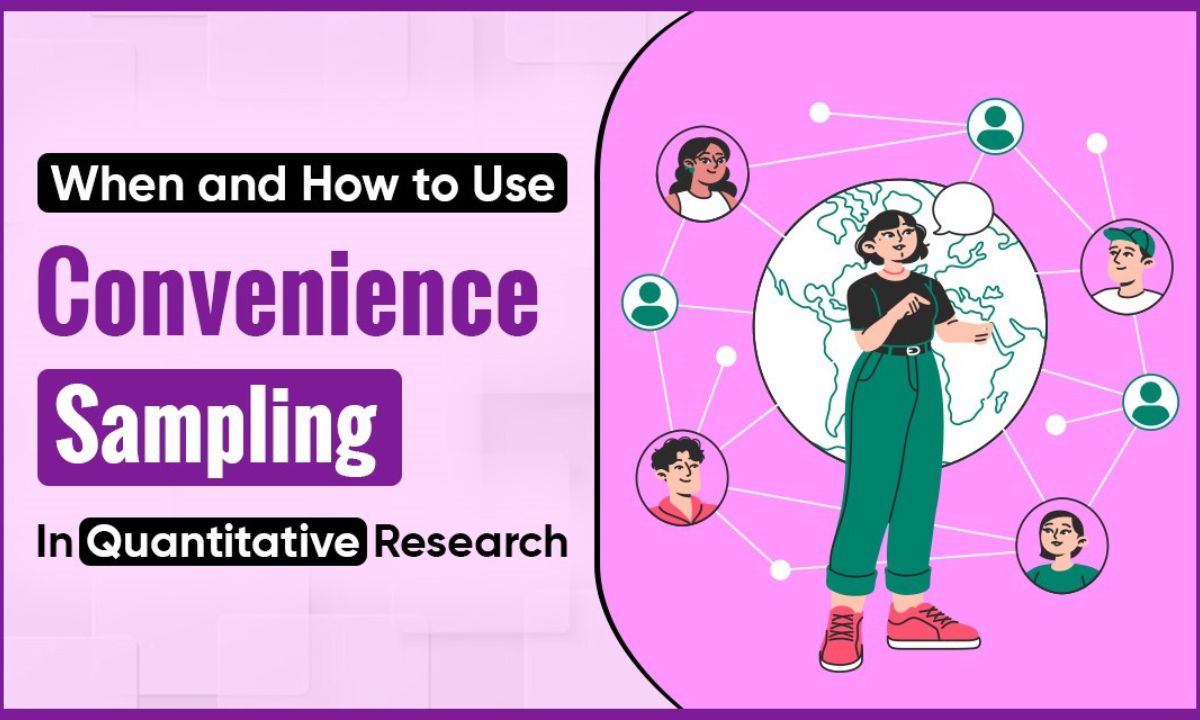Are you short on time and budget but need to do quantitative research for your paper? Convenience sampling can be your go-to method in limited resources to get quality information instantly and effectively. It not only simplifies the data collection process but also makes the information more accessible. However, the real task is to understand when and how to make use of the samples of convenience method for your research.
The University of Bath states that if you want to produce meaningful results from your quantitative research study, you should explain why you chose a certain number of participants by convenience sampling. So, whether you are a researcher managing a real-world study or a student working on a dissertation, getting your hands on reliable data is crucial.
In this article, we will help you learn the best use cases of convenience sampling in quantitative research, along with when and how to use it correctly to make an impact.
What is Convenience Sampling?
International Journal of Education & Language Studies states the convenience sample definition in a way that it is a process of research where the researcher selects a targeted population to collect the specific data effortlessly. It is a completely non-probability method where most researchers find nearby and readily available participants to gain the data for research.
Furthermore, you can use these samples of convenience strategy at various places like in classroom research, surveys, pilot studies, and other scenarios where speedy findings are more important than excellent accuracy.
For example,
You can take the convenience sampling example as a teacher at a University conducting some research on professors’ development and behaviours towards students. He will select the targeted audience of the same university’s faculty and students, making the information more accessible than ever!
Convenience Sampling – When and How to Use It in Quantitative Research?
Although a convenience sample comes with plenty of benefits for researchers, it still has some drawbacks, such as biased results. That’s why, before using it for your project, you must understand when and how to use it to enhance your research work instead of ruining it further. Some students who are not experts in using such methods mostly prefer to hire dissertation writing services for their tasks. These professionals have the right expertise and the knowledge to complete your dissertations effectively on time.
The following are some tips and tricks to comprehend the situations when you should use convenience sampling and how to apply it effectively.
1. When You Have Limited Time and Budget
Most of the time, students are in a hurry to conduct their research due to a looming deadline, making them tense. Moreover, the second thing that enhances their stress is the tight budget or low funding. In such circumstances, convenience sampling is the best option. Without undergoing difficult processes, you can gather data from people who are willing or nearby within a very short period of time.
The following are some tips to help you achieve this task easily:
- You should consider nearby community options like university fellows or online questionnaires to get data instantly.
- Make sure your research topic is relevant to the sample group’s accessibility.
- For honesty, provide a note about your time and financial limitations in your methods section.
2. When You’re Performing an Exploratory Study
While conducting research, there comes a time when you need to test various hypotheses to check whether it is working or not. To apply those tests and get quicker results, convenience sampling is the best way not only for testing ideas but also to improve the tools and patterns.
Here are some tips to help you focus on during an exploratory study:
- Make sure your sample size is both reasonable and representative of the available population.
- You should make use of the results to improve your tools before conducting larger representative research later.
- You should also portray in the results that the data you obtained is for research purposes only and should not be used to make conclusions.
3. When It’s Easy to Reach the Target Population
Among the best times to use the convenience sampling technique it is when you can reach the targeted audience readily and easily without making any efforts. So, if you get your targeted population for research just around you, like university fellows, coworkers, or professors, it would be feasible to access the data accurately.
Follow these quick tips to streamline the task:
- Firstly, you should select your targeted people and reach them when they are all available.
- To reach a wide range of people, you should arrange data gathering at several times or locations.
- Don’t limit your sample to those with similar backgrounds or opinions.
- Try to make your sample and results more diverse to enhance their effectiveness.
4. When Your Research Topic Is Low-Risk or Non-Sensitive
Convenience sampling works well for casual, non-sensitive, and commonly used subjects where accuracy and ethical considerations are not particularly important. For topics that demand a high accuracy rate, this sampling technique is not beneficial. So, for writing a successful dissertation, you must carefully choose between the sampling techniques according to your topic of study.
Follow these tips here:
- To steer clear of ethical pitfalls, ask straightforward, impartial questions.
- Even if the subject seems safe and cannot cause conflicts, you should still get informed consent for research.
- When explaining your sample strategy, provide a statement on the low-risk character of your topic.
5. When You Need Quick Responses or First Thoughts
Convenience sampling works well if you need to quickly obtain opinions on things like product reviews or classroom behavior patterns. For example, if you are working on a survey to ask students how the use of AI is helping them in their studies, you can provide them a chart with multiple-choice questions or a tick or cross for immediate results.
The following are some tips to help you easily navigate through this:
- You can seek opinions from different platforms like social media polls, college surveys, or Google Forms.
- You should prioritise privacy to ensure honesty throughout the survey.
- You should make use of statistical methods and instant answers instead of long theoretical ones.
6. How to Use Convenience Sampling the Right Way
After understanding when to use this strategy, now it is the timw to learn how to use it the right way to get reliable results quickly. It is the method of research that demands proper planning from the topic selection to research and applying sampling technique. It demands you to design a plan as ethical and legitimate as possible for ideal results.
The following are some tips to perfectly make use of this convenience method:
- According to your topic, you should first select the targeted audience that is accessible as well as educated enough to participate.
- You should be open and honest about the constraints of your sample strategy.
- You should record everything stepwise like who you selected as the audience, where and when you conducted the survey, etc.
- Diversify the time periods and places of your sample to reduce bias.
- Don’t exaggerate your results from the sample group.
- When possible, combine with additional sample techniques (such as quota or stratified sampling) to increase credibility.
Why is Convenience a Good Sampling Method?
NIH studies reported that convenience sampling is a good method for quantitative research as it is cheap, accessible, quick, and easy to execute. So, whenever you get a very short time and limited resources for your project, you can benefit from this technique as it helps you get reliable data from different communities who are willing to participate in a survey.
Although it reduces generalisability, researchers still make use of it for simple and effective answer keys. Moreover, it would be very useful for you if you are a beginner and are going to conduct a low-risk study.
What are the Drawbacks and Effects of Convenience Sampling?
According to a published paper on Researchgate, the following are some drawbacks of the convenience method:
- It comes with the risks of biased results.
- Its systematic errors reduce the credibility of research work.
- It lacks generalisability, resulting in unclear outcomes.
- You cannot get the right value of p and measure the variability correctly.
Whereas the effects of this convenience sampling method include:
- It’s possible that the report doesn’t fairly represent general trends.
- If it’s not openly recognised, it can make your study findings less credible.
- If the sample group has similar traits or histories, the results might be biased.
Conclusion
No doubt, convenience sampling comes with its own set of advantages for both students and researchers, but mastering the art of using it effectively is also crucial. Here, we have covered a comprehensive guide on when and how you can use this easy method for your research work. By using this prestigious technique, you would be able to complete your quantitative research quickly and gain valuable insights from such experiments.
However, if you are a beginner and cannot use it ethically for your project, you can acquire assistance from British dissertation writing companies. Their expert staff can complete your research work perfectly, even if you are short on time, budget, or resources. So, by applying these given tips and getting professional support, you can put yourself on a journey of accurate quantitative exploration for your research work.
Author Bio
Gloria E. Williams is a dissertation writing expert and an experienced researcher passionate about conducting quantitative research using convenience sampling techniques. She provides valuable assistance to students to solve their queries and streamline the path towards excellent dissertation writing.
ALSO READ: Science Lessons Lol: Turning Science Into Fun and Fascination











